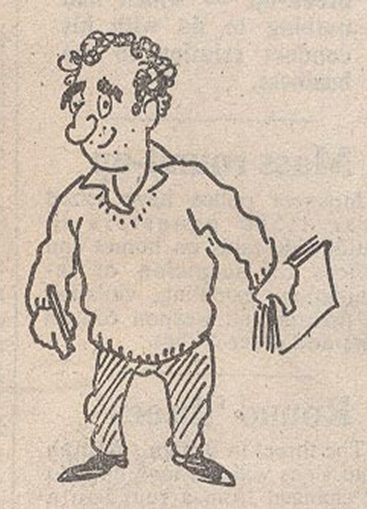
Self-portrait, Public domain, via Wikimedia Commons
Très bien pour un cadeau gratuity!
Having time to sit down and read a book is a bit of a luxury for me, as well as the fact that I don’t have the patience to sit still for long. There is something special about the smell and feel of a brand-new book. Turning over each page for the first time, sometimes even having to gently tease apart two pages that haven’t quite been cut properly. However, books aren’t cheap and I have become a fan of Kindle with ebooks available at 99p. What’s even better is the offer of a freebie book.
The other day I got an email offering me just that – a complementary ebook from the Inspector Pel series. I’d never heard of the character before, or the author – Mark Hebden – however I do love a good murder – Morse, Poirot, Miss Marple, Midsomer Murders, Lewis etc. Without delay, I downloaded the ebook – “Death Set to Music” – and settled back.
There was something about the writing which took me straight back to a black and white episode of Maigret. Impossible to read without putting on a French accent and imagining every office surrounded by an increasing fog of Gauloise smoke! The story set in Burgundy features grumpy, worn-out Chief Inspector Evariste Clovis Désiré Pel as the protagonist and his inevitable, put-upon side-kick Sergeant Darcy who describes himself as a “fornicologist”. No other officer is able to tolerate Pel’s sarcastic tone and cantankerous nature other than Darcy – an idea pair!
The story is undated however there are several clues as to when the events took place. The number plate format is based on the FNI system (Fichier National des Immatriculations) introduced in 1950. However, a better clue than that is from Pel’s visit to one of his early suspects, neighbour Monsieur Laye, and refers to his desk as being “full of gadgets, panels, buttons and lights as the dashboard of a Boeing 747.” It seems then that the story would be set in the very late 1960s or early 1970s.
Hebden paints his characters in detail. The facial expressions of the officers jump out of the page as they are being derided by jaded Pel. Poor young plod Nosjean – constantly put upon by Pel! We could hear his protests “like the bleating of a shorn lamb,” we could see his mental cogs whirring “if he had to do two things at once he’d made a mess of both of them” and we could sense his panic as he “backed away like a startled foal, the whites of his eyes showing.” Poor Odile, daughter of the murder victim, was painted as a petulant, unattractive and naïve teenager. But we can’t help but feel embarrassed for her as she made a misguided pass for the Italian gardener.
Pel is an inveterate chain smoker forever promising to himself that he has smoked his last. It’s never to be. However, the amount of alcohol that he drinks throughout the day would put even Chief Inspector Morse to shame and probably put a small elephant into a stupor. On the first day of the investigation, having visited the scene of the crime, Pel and Darcy take an aperitif before a lunch of tripe and some wine. They then return to the scene where Pel took a beer from the housekeeper, a glass of wine from the first neighbour “big enough to drown a cat in”, a Pernod from the second neighbour “as imposing as Madame Germain’s glass of wine” and another Pernod over supper with Darcy before driving home. But with his housekeeper having the TV blasting away, Pel retired to a bar for the night drinking more beer.

I’m not going to go into the plot in detail. It’s a light read and won’t challenge the most academic of brains however it’s a lovely throw-back to a time when an Inspector could drive around Burgundy many times over the limit and when workplace bullying hadn’t even been invented yet. A happy time when the author could get away with using the line “she apparently didn’t believe in make-up when a little would have worked wonders.”
The book was also published in 1995 under a different title “Pel and the Parked Car.” Without being a spoiler it’s fair to say that number plates are referenced several times throughout the story. Pel explains a number plate which had been written on the wall in the gardener’s shed – 1167-BR-75. This is based on the FNI (Fichier National des Immatriculations) format which has a chronological element and a regional element. It is made of three parts:
- First part: one to four numbers
- Second part: one to three letters
- Third part: the code for départments
For example, the first plate issued in Paris would have been 1-A-75 (75 being the department code for Paris); the second plate 2-A-75 so on to 999-A-75, and then 1-B-75 and around we go again. Some letters are removed such as I and O because they could be confused with digits, U and V can be confused with each other and combinations of M with W because they take up too much space. JO was reserved to celebrate the 1992 Winter Olympics in Albertville. After the various letter restrictions, the number of permitted car plates using the FNI format has been estimated to be in the region of 13.4 million using the formula (999 × 22) + (999 × 14 × 23) + (9988 × 9 × 23) + (988 × 21 × 23 × 23).
Finally, a little about the author Mark Hebden, which is in fact one of two pseudonyms of John Harris – the other being Max Hennessy. Born in Rotherham in 1916, Harris worked as a reporter on the Sheffield Telegraph before serving in the RAF as a corporal attached to the South African Air Force. Harris re-joined the Sheffield Telegraph as a cartoonist, with his first novel “The Lonely Voyage” published in 1951. He went on to write in excess of 80 novels including 17 in the Inspector Pel series starting with my first read, Pel and the Parked Car (or “Death Set to Music”) published in 1979. Harris’ daughter continued to write Inspector Pel mysteries after the death of her father, adopting her own pseudonym, Juliet Hebden.
© Hamster Wheel 2021
The Goodnight Vienna Audio file



